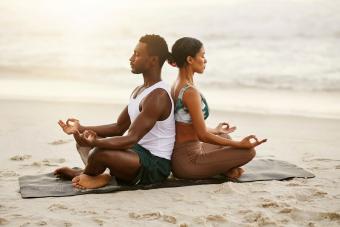
At one time, the use of the word asana was a reference to the original seated postures of yoga and mediation as well as the relation of one's spirit to a higher power. The basic definition of asana, derived from the Sanskrit word "to sit," is any one of the various positions of the body performed in yogic exercise. This definition is what most practitioners think of when they use the word today.
Western yoga exercisers are most familiar with the practice of asanas as a segment of one yoga path, Hatha Yoga.
History
The roots of yoga expand deep into the Hindu culture, going back thousands of years. However, Indian sage Pantajali is credited for establishing the foundation and inspiration for the classic belief and form of yoga as most of us know it today. Many cite his theorem within the Raja Yoga Sutras, based on the study of ancient yogis, as the modern yogi's guide to living.
Over time, people disregarded other parts of Pantajali's total philosophy, yet millions of yoga gurus and students worldwide still embrace the eight steps of the Yoga Sutras.
The total extent of yoga's philosophy of the asana is not explored when it's simply considered a posture. In Western culture, many people think all there is to yoga is for you move from one posture to another, and the result is that you might become really fit. However, postures are just one component that lead to a true yogic experience. Combined with pranayama, asanas are stepping stones to the ultimate goal of enlightenment.
Pantajali's eight steps of the Yoga Sutras:
- Yamas: explores truth, morals and personal conduct
- Niyamas: contentment, surrender of the ego
- Asanas: steady poses
- Pranayama: control of breath and vital energy; together with asanas
- Pratyahara: withdrawal of the senses
- Dharana: mastering concentration
- Dhyana: examines meditation
- Samadhi: experiencing the super-conscious state
To learn more about the Yoga Sutras, consider the book The Yoga Sutras of Patanjali: Commentary on the Raja Yoga Sutras by Sri Swami Satchidananda.
The Physical Benefits
The focused activity of asanas is said to:
- Lubricate the joints, muscles, tendons and ligaments
- Improve circulation and the activity of the nervous system
- Increase flexibility
- Release tension
As the body is being nurtured and conditioned through regular, nonabrasive movement, yogis believe asanas expand mental faculties and enhance spiritual capacity as well. In Yoga Journal, Dr. TImothy McCall outlines more detail about these and other benefits of yoga.
General Guidelines
As with any other physical motion, there are certain recommendations designed to enhance results. The Yoga Practice Center provides a more comprehensive list of guidelines to consider, but here's a quick overview:
- Stay hydrated throughout the day. Have at least eight ounces of water prior to practice.
- Perform asanas on an empty stomach, usually in the morning or three hours after your last meal. If you need energy, have a piece of fruit one hour prior to exercising.
- Inhale and exhale through the nose unless otherwise instructed.
- To aid in concentration, exercise in a calm, warm environment.
- Although there is a difference of opinion on this issue, it is commonly suggested that women avoid doing inverted poses during menstruation. Other asanas may certainly be practiced during this time. However, pregnant women should definitely avoid inverted poses and certain stomach poses after the first three months.
Begin Your Practice
What Do Asanas Look Like?
There are approximately 600 asanas, each with a unique purpose and benefit. Postures such as Downward Facing Dog and Warrior may look familiar because these are frequently-used images associated with yoga. If you look at LoveToKnow Yoga's Pose Gallery, you'll find a selection of asanas featuring benefits and instructions to help you become more comfortable with some popular poses before you start practice.
You can also learn a lot about postures by reviewing the slideshows Beginner Yoga Stances, Pictures of Yoga Postures, and Yoga Sun Salutation Steps.
Finding Instructors and Classes
The best way to understand the power and point of the movements is to learn from an instructor. An instructor will guide your body into the right pose to improve form and avoid injury. You can find certified yoga instructors at yoga studios, fitness centers, spas, and community centers. The Yoga Finder website is probably the most comprehensive listing to help you find classes and instructors near you.
If classes aren't available when you'd like to practice, another option is to try an online course. The Yoga Learning Center and Yoga Class.com shake up the routine of using the same DVD or video and provide forums to learn more about yoga.







